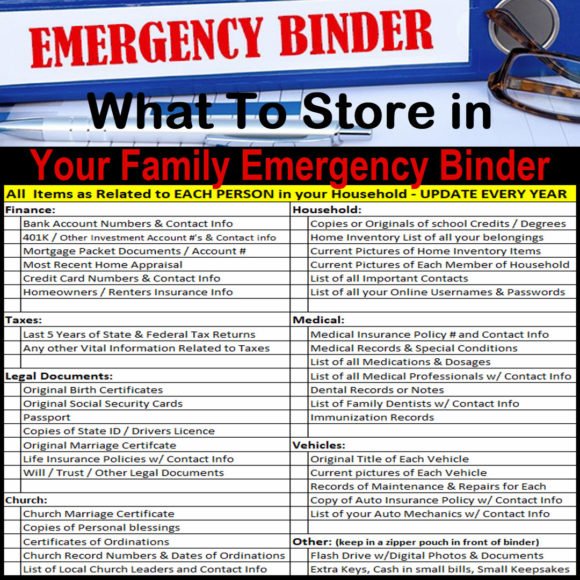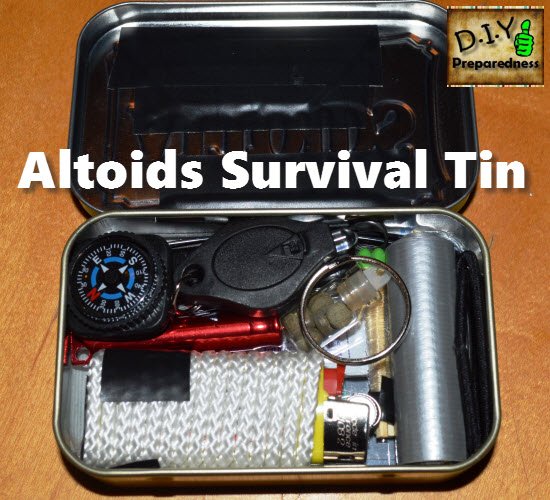November 2, 2024 | Getting Prepared, Temporal Preparedness | No Comments

– 2020 UPDATED POST –
Truthfully, I’d never even heard of an Emergency Binder. So I was intrigued a while ago when my friend did a presentation in our ladies church group showing her binder and the why, what and how she did it. She talked about how after the tragedy of 9-11,
there were some widowed women who were really struggling with the loss of their partner. One specific couple had chosen not to be married but lived many years together and were expecting their first child. Since there was no marriage certificate, she ended up losing the home (it was in his name) and did not receive any of the money donated to the families of the victims. That really struck me at how important it is to have your documents and keep them easy to access.
== NOTE: If you’d like to get your Emergency Binder together, but lack the time and energy to organize it; you can now purchase my Emergency Binder Kit here, complete and ready to populate, from my new website: preparednesskits.net. ==
So after I learned this, I was on a mission to make my own. I may have done more than I needed to, but don’t let this discourage you from putting your own together. You don’t need to go to the efforts that I have for it to be a huge benefit to your family.
- First, I found a sturdy 2″ binder.
- I already had heavy weight sheet protectors.
- I wanted my divider tabs to stick out beyond those sheet protectors, so I cut a thick card-stock paper the same width as my sheet protectors and I bought the divider tabs that are self-sticking to adhere to your own page. That way, my tabs stuck out to where I could see them.
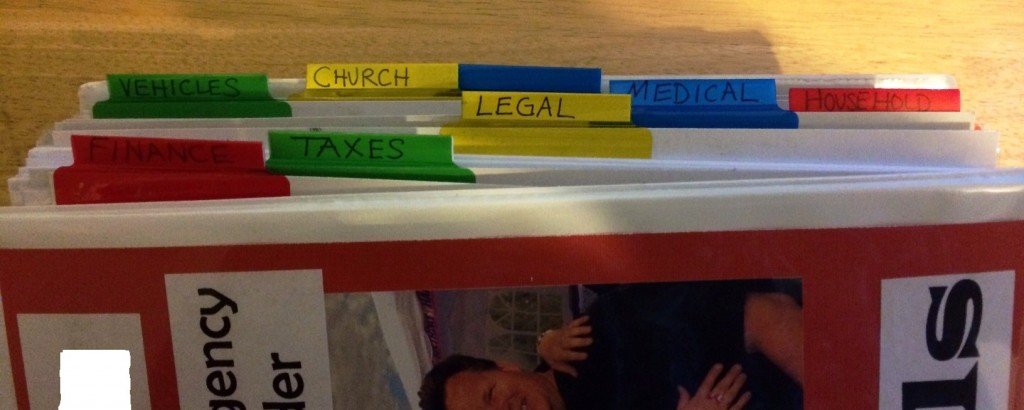
The categories I did for my family binder are: Finance, Taxes, Legal, Medical, Household, Vehicles, and Church. Below I will share what basic kinds of things I put into each category.
1. Finance
- List of each Checking & Savings account of everyone in the family with the Bank name/address/contact numbers, Account Number.
- List of all investments: retirement accounts, stocks/bonds, whole life insurance, etc. with the Institutions name/address/contact numbers, Account number, interest, and any rules regarding each account.
- List of all debts (Mortgage, car loans, student loans, credit cards, etc.) including each Bank name/address/contact number, Account number, interest rate, monthly payment, & due date.
- List of monthly bills, Name/Address/ Phone/ Account numbers and when each are due
- List of all sources of income, with contact information for each
- Any accidental death insurance policies offered by my bank
2. Taxes
- Make a copy of the last 3 years of state and federal tax returns – just the main pages not the whole return.
- Any other vital information related to taxes
3. Legal
- Originals of all Birth Certificates and Social Security Cards of each member of your family
- Copies of State ID or Drivers Licenses for each member who has one
- Original Marriage Certificate
- Life Insurance Policies with the Company’s name, address, phone number, and Policy number
4. Medical
- Medical records or notes for each member of the family (including blood type, allergies, major concerns or sicknesses, past surgeries/injuries )
- List of medications and dosages for each member of the family
- List of all family Doctors and medical professionals including addresses and phone numbers
- Dental records or notes for each member of your family
- List of family dentist(s) with address and contact information
- Immunization record for each member of your family applicable
5. Household
- Password Keeper – a list of ALL online accounts with user names and passwords
- Copies or Originals of school credits or degrees
- Mortgage packet documents – just put the whole pack in there (or rental agreement if renting)
- Latest appraisal and any other official information about your home
- List of your all your belongings, including serial numbers and pictures or videos on USB drive if you can
- Homeowners or Renters Insurance Information – Company, address, contact information
- Up to date pictures of each member of your family, and of you all together. If you get separated, having pictures to identify and help find your loved ones may be crucial and pictures to “prove” you are a family in certain situations might be needed.
- List of all important family and friends with their contact information
6. Vehicles
- List of all your vehicles with License plate, VIN number, date you got it, lien holder info (if applicable), and description with pictures
- Original title of any vehicle you own
- Basic records of upkeep, repairs and maintenance for each vehicle
- Copy of your Auto Insurance Policy with the Company’s name, address, phone number, and Policy number
- List of your Auto Mechanics with their address and contact information
7. Church
- Church marriage certificate, certificates of ordinations (baptism, priesthood, etc.) and special achievements
- Copies of personal blessings
- Church record numbers and dates of ordinances for each member of the family
- List of church leaders and contact information
BONUS:
- Keep extra keys to your home, garage and vehicles in a zipper pouch in the front of your binder so if you lose your other keys, you’d have your emergency backup.
Remember after you get your binder together, to go through it at least once a year and UPDATE the information so it can be as current as possible. Tax time is a perfect time to review and update your emergency binder. Updating every 6 months (daylight savings time) is even better.
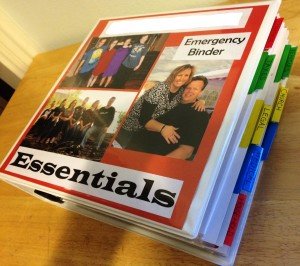
********** 2020 UPDATED BINDER: **********
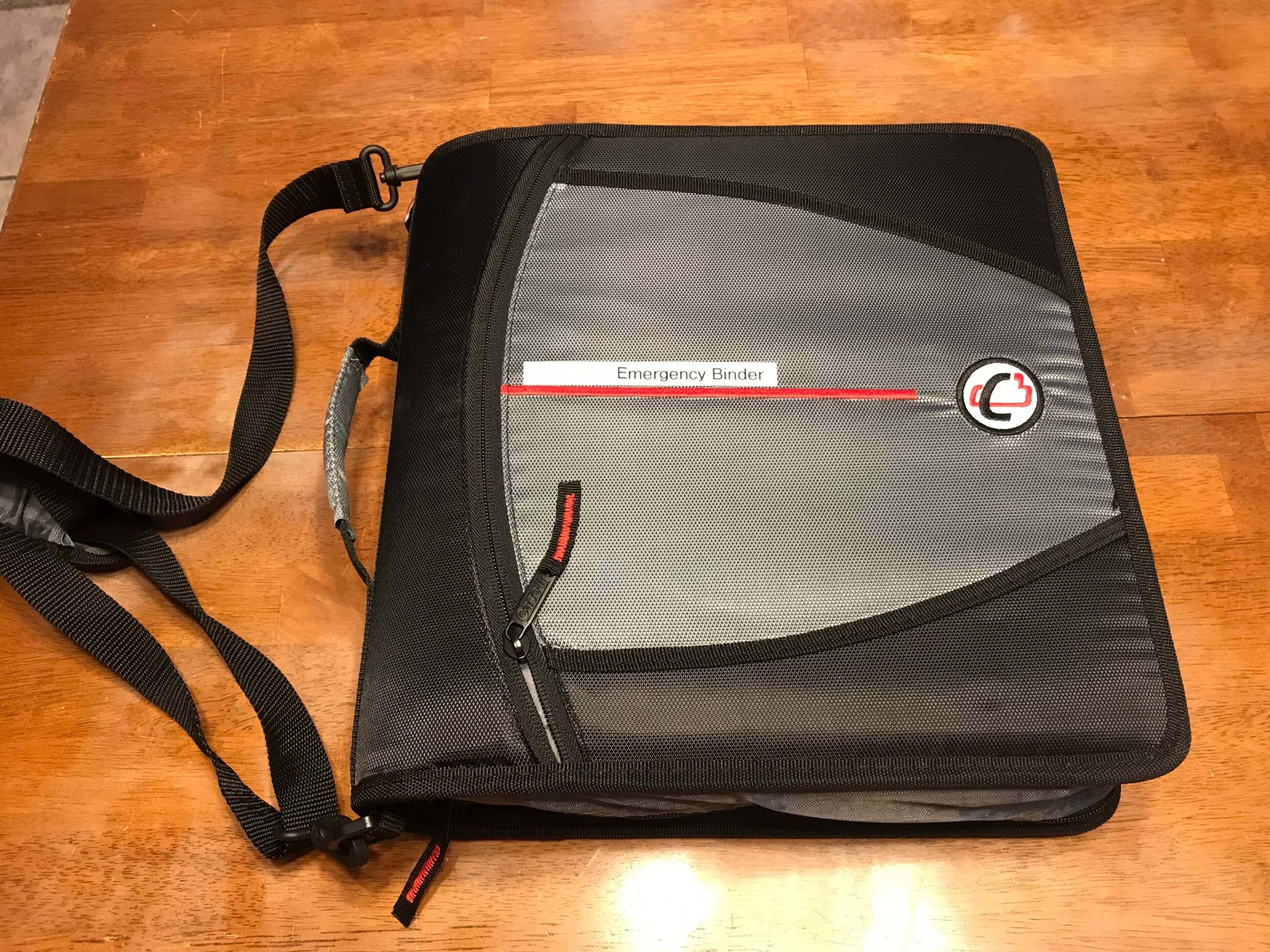
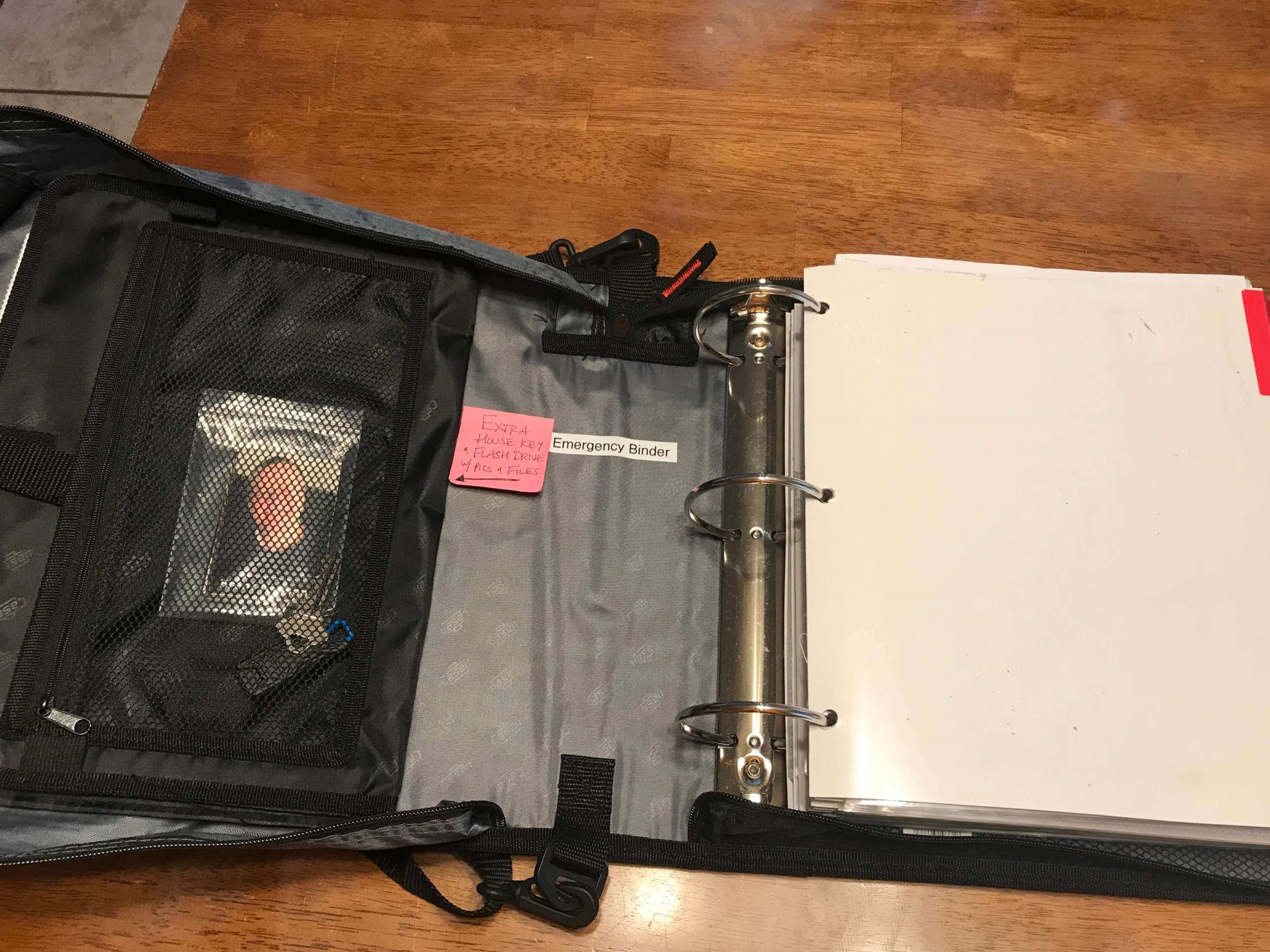
Just looking over this, you may be thinking “That’s crazy to have all that vital information in the same binder where a burglar can just take it.” In some sense, that seems true. But in another sense, how many burglars go looking around through binders when they rob a home? Is that even on their stealing agenda? You could name your binder something that a thief wouldn’t even be looking for like “Uncle Ted’s Journals” or “Grandma’s Stories”.
Also, my friends recommended storing your emergency binder in a fire proof safe. A large enough safe may also be a deterrent for any thief who wants a quick get-a-way. If getting a safe isn’t in the cards right now, you could opt for a safety deposit box at the bank. Or find a secure location in your home where it would least likely be discovered by an intruder.
(Example story from my friend)
Once she was scheduled to fly out in the morning for a trip while her family was away, and that night she discovered her basement had flooded. There was no one else in the home to help, so she quickly grabbed her Emergency Binder and was able to promptly access her homeowners insurance company and speak to everyone she needed to so it all would be taken care of. Amazingly, she was STILL able to leave for her trip early the next morning. Having that binder helped her be focused and prepared so that a horrible situation was resolved more quickly and didn’t even ruin her travel plans.
Also, just thinking about a situation where my home might be destroyed and I need documentation that I owned the home, or of my belongings, I would have it right there. Emergency situations are already traumatic and can leave you in a panic, but having all your most important documents and information right with you can certainly ease a bad situation and help give you peace of mind. Especially when it comes to being separated from loved ones.
~Margene
******* UPDATE Picture of Quick List for your Emergency Binder ********
